Some five hundred years after the time of Salivahan Maharaja, a king
in his family line named Bhoja Raja crossed the Sindhu river into
Gandhara (Afghanistan) and other westward lands. Bhavisya Purana
states that while he was in this western region, Bhoja Raja worshiped a
Sivalinga situated in the desert.
nripascaiva mahaadevam marusthalanivaasinam
gangaajalaishca sasnaapya pancagavyasamanvitaih
candanaadibhirabhyarcya tushtaava manasaa harim
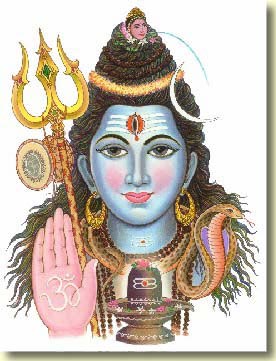 |
|
For persons in
darkness and ignorance, Mahadeva Lord Shiva is God. He is
known as Bhutanatha, the lord of ghostly entities like
pishachas, yakshas, and rakshashas. And he is the lord of
destruction. Direct or indirect worship of Shiva is seen in
many guises all around the world. His linga (symbol) is a
type of stone. Ganga-devi lives in his matted locks; thus
wherever Shiva appears, the water of the Ganges appears
also.
|
He offered that linga Ganges water, pancagavya and sandalwood
pulp.
From Kartik Prabhu's notes, we learn that the central shrine of Islam
is the Kabba, which is a cube-shaped, one-room stone structure in Mecca,
Saudi Arabia. In pre-Muslim Arabia it already attracted pilgrims as the
most important sanctuary. The traditional belief is that it was built by
Abraham and Ishmael (to whom the Arabs trace their descent). This is
confirmed in the Qur'an (Koran). A black stone is worshiped in the
shrine. This kaaba stone is also called as Sange-Aswad, which is
corruption of Sanskrit linga-asveta which literally means the
Black (asveta=not white) Shiva Linga.
Near this shrine there is a sacred well called Zamzam, a name that
sounds remarkably like "ganga. " The Zamzam well was holy even before
the rise of Islam in Arabia, and it remains holy to the Muslims. It
appears that Bhoja Raja bathed the Shivalinga with water from this well,
which is non-different from the Ganges. That a well far from the Ganges
river yields Ganges water is not remarkable. There is such a well at
Ramesvaram in South India.
Bhavisya Purana continues:
etasminnantare mleccha aacaaryayena samanvitam
mahaamad iti khyaatah shishya shaakhaa samanvitah
At that time a mleccha acarya, famous by the name Mahamad
(Mohammad), dwelt there accompanied by his followers.
Kartik Prabhu notes:
The prophet Mohammad (570?-632), founder of Islam, taught
political and social as well as religious principles that are the basis
of Islamic civilization and that have had a vast influence on world
history. Mohammad was born in Mecca. He belonged to the clan of Hashim,
a poor but respected branch of the prestigious and influential tribe of
Quraysh. His father died before he was born, and after his mother's
death when he was six, he was brought up by his uncle Abu Talib, who was
the priest at the kaaba.
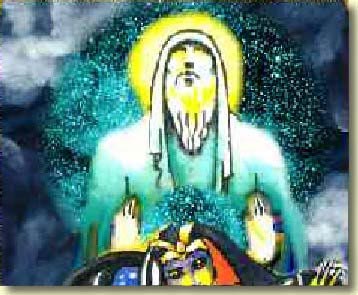 |
| The prophet Mohammed propagated the religion
of Islam among the people of the Arabian desert. |
Mecca (Makkah, called Macoraba in very olden times), is a city
in western Saudi Arabia. It is located in Al ijaz (Hejaz) Province near
Jiddah. Mecca is the most sacred of the Muslim holy cities. Muslims
around the world must face Mecca during their daily prayers. Every year,
during the last month of the Islamic calendar, more than 1 milion
Muslims make a pilgrimage, or hajj, to Mecca. The city's location on
several trade routes has made it commercialy important since ancient
times. Mecca was a religious center before the time of Muhammad, and
several holy sites within the sacred precincts of the great mosque,
called al-Haram, had religious significance in pre-Islamic times.
Many Vedic deities were worshiped at Mecca in pre-Islamic times.
These were destroyed by Mohammad and his followers. The Kabba, a
windowless cube-shaped building in the courtyard of the mosque, is
believed to have been built by the Hebrew patriarch Abraham. In the
southeastern corner of the Kaaba is the Black Stone, supposedly given
to Abraham by the angel Gabriel. Also within the precincts of the
mosque is the sacred well, called the Zamzam (Zemzem), a corruption of
Sanskrit word Ganga, which was reputedly used by Hagar, mother of
Abraham's son Ishmael. The city is first mentioned by the Alexandrian
geographer Ptolemy, who in the 2nd century ad called it Macoraba.
Mohammad secretly came to meet Bhoja Raja, as the Bhavisya Purana
now describes. It appears that this meeting took place before Mohammed
had achieved prominence in Arabia.
raatrau sa devaruupashca bahumaayavishaaradah
paishaacam dehamaasthaaya bhojaraajam hi soabravit
At night, he (Mohammad) of angelic disposition, this shrewd
man in the guise of a Pishacha [a desert spirit or jinn], spoke to Bhoja
Raja.
aaryayadharmohi te raajansarvadharmottamah smritah
iishaagyayaa karishyaami paishaaca dharma daarunam
O Raja! Your Arya Dharma has been considered to be the best of all
religions, but according to the commandments of the Supreme Controler,
I shall enforce the strong creed of the Pishachas.
lingacchedii shikhaahinah shmashrudhaari sa
dushakah
uccaalaapii sarva bhakshi bhavishyati jano mama
My followers will see to it that men are circumcised and that they
wear no shikha on their heads. Instead they will wear beards and
behave against brahminical principles. They will call out loudly in
their prayers. They will eat all things.
binaa kaala caa pashavaasteshaaam bhakshyaa mataa
mama
naimusaleva samskaarah kushariva bhavishyati
According to my teachings, they will eat all animals except swine.
They will not seek purification by sitting on Kusha grass, rather
their purification will come by warfare. (Musal).
tasmaanmusalavanto hi jaatayo dharmadushakaah
iti paishaaca dharmashca bhavishyati maya krutah
They shall be known as Musal because of their battles with
irreligious nations, and I shall be known as the originator of this pisaca-dharma.

The Beginning of Quarrel
An asura is defined as suravirodhi , a being of
intelligence and power who does not agree with the suras or
demigods. The suras are ever-firm in their devotion to Lord
Visnu: om tad visnoh paramam padam sada pasyanti surayah--"Lord
Visnu, who is beyond this world, is sought by the suras. " (Rg Veda
1. 22. 20) But as Padma Purana makes clear, asuras tad
viparyaya , "Visnu and His devotees are opposed by the asuras. "
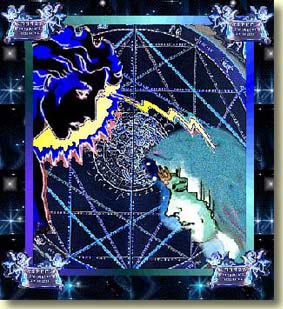 |
|
Even the superior beings who
dwell in the upper levels of the universe are divided by
disagreement and quarrel.
|
In ancient times, so the Vedas report, the asuras were once
equals of the suras in every way. But their disdain for serving
anyone other than their own selves grew so strong that it polluted their
performance of Vedic dharma. From Satapatha Brahmana 5. 1. 1. 1.
we learn the following.
devas ca va asurasca. ubhaye prajapatyah pasprdhire
tato
'sura timanenaiva kasmin nu vayam juhuyameti svesv evasyesu
juhvatas cerus te 'timanenaiva parababhuvus tasman natimanyeta
parabhavasya haitan mukhamy yad atimanah
Both demigods and demons come from Prajapati. The arrogant
demons asked, "To whom should we offer?" They placed the offerings into
their own mouths, and through arrogance they were overcome. Therefore no
one should be arrogant. Arrogance is indeed the source of destruction.
Sripad Madhvacarya, in his commentary on Bhagavad-gita 7. 15,
defines asura thus: asusu rata asurah--"Those who take
pleasure in the enjoyments of life are asuras. "
But it wasn't always like that. Verse 26 of Mahabharata 7. 221
tells us that the demons used to be firm adherants of dharma
(religion): asuresvavasam purvam satyadharmanibandhana. They
followed svargamarga, the pathway to heaven (verse 28), they
gave charity, they performed sacrifices, they worshiped guru and
gods, and they showed hospitality to learned brahmanas (verse
29). But in time lust and anger covered these virtues. Mahabharata
3. 92. 6 says that during a period of history known as the Deva-yuga,
the asuras became distinct from the demigods at the moment they
abandoned dharma. Laksmi (the goddess of good fortune) left
them, and Alaksmi (the goddess of misfortune) became their constant
companion (verse 9). Verse 10 states:
tan alaksmi samavistan darpopahatacetasah
daiteyan danavams caiva kalir apy avisat tatah
Kali entered the demons, whose minds were afflicted with pride
and who were surrounded by Alaksmi.
Kali (a male personage, never to be confused with goddess Kali) is
quarrel personified. His family lineage is described in Srimad-Bhagavatam
4. 8. 2-3. It begins with Brahma, the creator and soon comes under the
shelter of Nirrti, the goddess of the southwest who is associated with
untimely death, difficulty, poverty and infertility. Kali consorted with
his own sister, Durukti (Harsh Speech), and begot in her two children,
Bhaya (Fear) and Mrtyu (Death). Wherever Kali is, there will be
irreligion, greed, falsehood, robbery, incivility, treachery,
misfortune, cheating, and vanity.
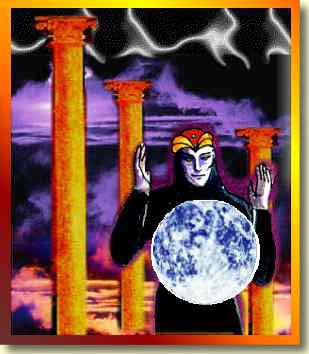 |
|
Kali in the dress of a king
spreads abominable activities all over the world.
|
By his superior skill as an agent of suffering, Kali became the leader
of the asuras as much as Brahma is the leader of the demigods by
his superior Vedic knowledge (asurah kali-prayanta evam
duhkottarottarah kalir duhkhadhikas tesu te'py eva brahmavad ganah).
So writes Madhvacarya in his Mahabharata Tatparya-nirnaya 1.
136. From Padmanabhasuri's Padartha-sangraha with Madhva's Siddhantasara
commentary (552), we learn that Kali appeared on earth five thousand
years ago as the rulers Duryodhana, Jarasandha and Sisupala. But these
were amsas (empowered expansions) of Kali. His mula-rupa
or root form lives on to this very day.
In that mula-rupa Kali takes the dress of a king to perform
abominable activities such as cow slaughter. Seeing his sinful behavior
not long after the Kuruksetra war, the great devotee King Pariksit
brought Kali under control. Kali then entered a young brahmana
and provoked him to curse Pariksit. After the king departed this world,
the Age of Kali spread over the whole earth.
Kali is ever on the lookout for discrepancies in a person's execution
of religion (dharma ). When, for example, the pious King Nala
forgot to wash his feet after going to the toilet, and then sipped water
and performed his sandhya rituals, Kali entered his body and
pulled him down to ruination. After a terrible struggle Nala at last got
free of Kali's clutches and recovered his former status, but those who
deliberately abandon dharma--i. e. the demons--willingly follow
Kali into the moral abyss.
However, Lord Krsna never abandons His parts and parcels, even when
they abandon religion and by so doing abandon themselves. Krsna comes to
this world again and again in many avatara forms so as to revive
dharma. Even to demons, He preaches dharma in ways that
they can accept and follow. And so He gives them a chance to change from
asura nature to sura nature.
In His form as Buddhadeva, for example, He preached against the
authority of the Vedas and thus attracted to Himself a large following
of nastikas or atheists. Having abandoned devotion to Visnu,
they became devotees of Buddha. But Buddha is Visnu. He put them
on the path of the four regulative principles respected by the Vaisnavas
(the devotees of Visnu): abstinence from meat, fish, eggs, onions and
garlic; abstinence from illicit sexual activity; abstinence from
gambling and unnecessary mental speculation; and abstinence from
intoxication.
But conditioned souls rarely change their natures overnight. When dharma
is practiced by persons who cling to their lower natures, it is called gauna-dharma
or religion influenced by the tri-guna, the three modes of
material nature--sattva-rajas-tamas, goodness, passion and
ignorance. Gauna-dharma in the mode of goodness lifts the spirit
soul into svarga , the heavenly realm of this material cosmos. Gauna-dharma
in the mode of passion puts the spirit soul into the martya-loka,
the realm of mortal human beings. Gauna-dharma in the mode of
ignorance leads the spirit soul down into the realm of ghosts.
Because these three situations are material, they are subject to
duality. Duality invites disagreement. If disagreement is seasoned with
arrogance, it provokes quarrel. To engage in quarrel means to come under
the control of Kali. If quarrel divides even the denizens of heaven
where goodness predominates, then how shall people of Earth who are
prone to be overcome by passion and ignorance ever be free of quarrel?
The Old Testament tells of the brothers Cain and Abel, the sons of Adam
and Eve. Both worshiped the Lord by the fruits of their work. Cain was a
farmer. Abel was a shepherd. Cain made an offering of vegetables and
grain. Abel made an offering of lamb.
Now, a devotee of Krsna might expect God to accept Cain's offering and
reject Abel's, but the Old Testament says the opposite. How to
understand this? Well, for one thing the Bible teaches mleccha-dharma.
For another, to make an offering that is externally in the mode
of goodness but internally corrupted by sinfulness is displeasing to the
Lord. And indeed this is why God told Cain he rejected his offering:
If thou doest well, shall thou not be accepted? And if thou
doest not well, sin lieth at the door.
Cain's inner sinfulness was exposed when in anger and envy he killed
his brother Abel. God told Cain that the earth which had drunk the blood
he spilled would henceforward not nourish his crops with her strength.
Thus farming would be a hard life for Cain and his descendents.
But God did not abandon Cain. The reader may have heard the expression,
"the mark of Cain. " People who have only vague knowledge of the story
think the mark of Cain is something bad, a mark of God's condemnation
perhaps. In fact, Cain worried aloud before God that his crime would
outrage other men to kill him, and so God replied that whosoever would
slay Cain would have to suffer seven times the deserved reaction for
murder; God put a mark on Cain's body for all to see so that no man
would dare do him harm. Thus "the mark of Cain" was actually God's
protection upon this fallen soul. The lesson is that even if one's
religious practice is polluted by great sins, he is still better off
than one who practices no religion at all.
Now, there is another kind of dharma that is untouched by the
three modes of nature. It is called mukhya-dharma. And what
religion is that? The pure chanting of the mahamantra Hare Krsna
Hare Krsna Krsna Krsna Hare Hare/Hare Rama Hare Rama Rama Rama Hare
Hare, or indeed the pure chanting of any names of God found in bona fide
scripture, is mukhya-dharma.
 |
|
Those who take shelter of Lord
Caitanya Mahaprabhu's sankirtana movement are raised out of
the duality of sin and piety. In that transcendental
situation, the personality of Kali cannot touch them.
|
Chanting the holy names of the Lord loudly to music is called sankirtana.
Sankirtana was introduced in the Kali-yuga by Lord
Caitanya Mahaprabhu as the transcendental religion of prema. Prema
means love of Godhead and love for all of Godhead's parts and parcels.
If one chants the holy names and is blessed by Mahaprabhu with a heart
flooded with prema, how then can Kali impell that person to
quarrel with others? Kali afflicts those who are in duality, which means
those whose hearts lack love of God and who are therefore under the
modes of material nature.
Duality means dharmadharma ("religion-irreligion"). Dharmadharma
is another way of saying gauna-dharma. It is a creation of the
material world, as Manu-samhita 1. 26 explains:
karmanam ca vivekartham
dharmadharman vyavecayat
dvandvair ayojayat cemah
sukha-dukhadibhih prajah
To distinguish actions (karma), the Lord separated
piety (dharma) from impiety (adharma), and He caused the
living entities to be affected by pairs [of opposites] such as pain and
pleasure.
In all different mixtures of the three modes, dharmadharma
manifests. In all its forms, dharmadharma is more concerned with
personal position and respectability--"I, me and mine"--than with
satisfying Krsna. Even among the low and fallen mlecchas,
someone like Cain thinks, "I am a high-class pious man. My offering to
the Lord is respectable. This other fellow, my brother here, has made an
inferior offering to mine. Why should he get more respect than me?"
Everywhere in the material world, on earth and in heaven, such division
and quarrel is going on.
But this egoistic me-versus-him dharma is not the
transcendental, nonmaterial dharma taught by Sri Krsna Himself
in Bhagavad-gita and Srimad-Bhagavatam. As the Lord
declares in Bhagavatam 11. 19. 27: dharmo mad-bhakti-krt
prokto--"Real dharma leads one to My devotional service. "
Srila Bhaktivinoda Thakura prays:
bhakativinoda nahi jane dharmadharma
bhakti-anukula tara hau saba karma
Bhaktivinoda knows neither religion nor irreligion. He simply
prays that all his activities be conducive for pure devotion to You. (Bhakti-anukula-matra
Karyera Svikara 1. 9, from Saranagati)
How does pure devotion to Krsna surpass the duality of religion and
irreligion? Consider the story of Haridasa Thakura and the prostitute.
Haridasa was the Namacarya, appointed by Sri Caitanya Mahaprabhu to be
the teacher of the chanting of the holy names for His sankirtana
movement. He used to live in a cave and chant hundreds of thousands of
names of Krsna each day. An aristocratic landholder grew envious of
Thakura Haridasa's fame. This man hired a young, beautiful prostitute to
seduce the Namacarya and so ruin his reputation as a saintly person.
When she arrived at his cave, Thakura Haridasa bade her to sit down and
hear while he chanted. Doing so, her heart was purifed. She renounced
prostitution and later became famous as a pure devotee herself. So the
point here is that Haridasa Thakura did not associate with this woman in
a sinful manner, as the envious landholder hoped he would; nor did he
try to maintain religious respectability in the eyes of the world by
rejecting her association outright. Haridasa was simply fixed in love of
God. Fully absorbed in the Lord's holy names, he could not be deviated.
His pure devotion set the woman on the path of pure devotion too.
The sankirtana movement spreads throughout the world by this
principle of transcendental association (sat-sanga ). Radha-krsna
bolo sange cholo ei matra bhika cai --"Chant the holy names of
Sri-Sri Radha-Krsna in Our association," Lord Caitanya Mahaprabhu and
Sri Nityananda Prabhu invite everybody. "These are the alms we beg. "
In such powerful and uplifting association, material duality cannot
intrude. Even among the purest personalities, bheda (difference)
will not disappear, since difference exists even in transcendence. The
individual soul (jivatma ) is always different from the Supreme
Lord, for example. But in transcendence, bheda does not
contradict abheda (oneness). Oneness in difference means
relationship, and love harmonizes and sweetens relationships. It's when
love is lacking that difference becomes hopelessly exaggerated by
selfishness and forces relationships asunder. By loving Krsna, the Self
of all selves, one can relate lovingly to all selves. In the absence of
that love, one is obliged by nature to try to love one's own self as
Supreme. In that event, harmony with other selves is impossible.
Of course, an individual always has his free will. If he wants to he
can refuse to enter the transcendental sanga of Sri Caitanya
Mahaprabhu and His associates. He can even try to oppose the sankirtana
movement. But he cannot stop it. And indeed by trying to oppose sankirtana
he has to associate with the chanting of Hare Krsna. Even such negative
association is purifying. Nearly five centuries ago the soldiers of the
Kazi, the Muslim ruler of Navadvipa in Bengal, tried to stop sankirtana.
The result was that these soldiers started chanting Krsna's name
themselves, even in the presence of the Kazi who had ordered them to
forbid others from chanting.





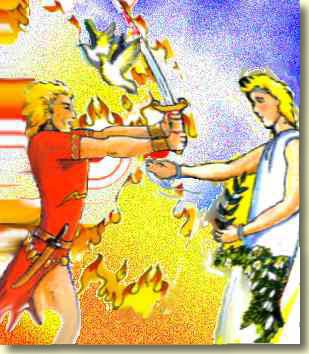

![[Home Page]](../grfx/bml_logo.gif)
